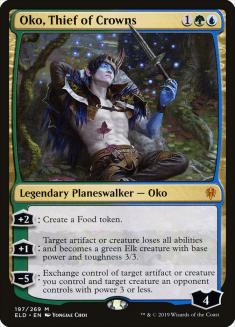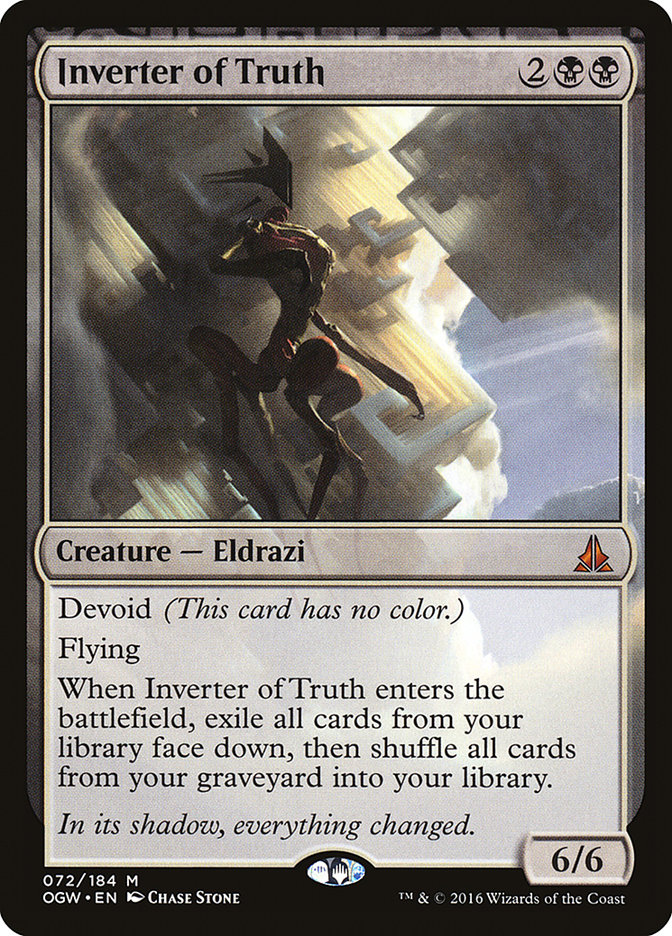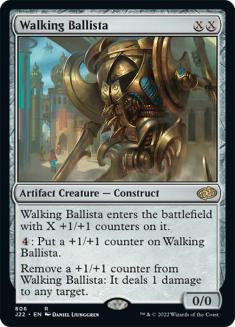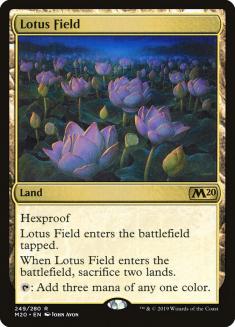Wizards of the Coast (WotC) announced Tuesday that there would be bans next week in Historic, Pauper, Modern, and Pioneer. I will be focusing on Pioneer specifically today, examining the cards I think should be banned, as well as what the format would look like without them. This kind of announcement comes with its own set of problems, including four lame-duck formats for seven to ten days while they implement the changes. Instead of focusing on the negatives, I will choose to focus on what good the changes can do.
The History of the World
Pioneer, specifically, has been in a holding pattern for six months now. The release of Theros Beyond Death completely altered the shape of the format, adding multiple new archetypes that essentially broke some of the rules they’d set in place from previous bans. Felidar Guardian was too good because of the “Splinter Twin” nature of the combo alongside Saheeli Rai, a one-two punch that knocks out anyone without a bunch of instant-speed removal. Tapping out could mean certain death, and the feel-bad moments caused by the game ending when someone put two cards together just felt so wrong.
Normally, a combo deck shouldn’t be able to interact fully with the opponent. Traditionally speaking, any combo deck that could aggressively interact with the opponent was always the head of the class. Copy Cat was the most recent iteration until the printing of Thassa’s Oracle. While the combo of Inverter of Truth and Jace, Wielder of Mysteries has been in existence the entire time Pioneer has been legal, it wasn’t really pushed to the forefront until we had a ton of bans and printed a backup way to win the game alongside Inverter of Truth. Having that added consistency was key, but the real kicker was the fact that the only way to stop a Thassa’s Oracle trigger was to counter the spell. Killing the creature is useless in a lot of scenarios, which means some decks just can’t actually interact with the combo if you have it early.
Combo decks that force you to live in their world while they interact with you on every turn can be some of the most frustrating games of Magic you’ll ever play. As someone who played Splinter Twin almost exclusively in Modern for two years, the feeling of playing a deck that powerful is simply impossible to describe. You feel invincible, and you feel vindicated when you win games against “the bad guy.” I often touted Splinter Twin as the one deck in the format that could police such a wild world, but the heart of the matter is that there was no policing necessary. I liked playing a control deck with a combo finish, and I also liked winning a lot. Because of that, I was one of the first people on the “unban Splinter Twin” train.
I am no longer a passenger on that train.
On VS Live, we would regularly explore the Modern format where Splinter Twin was legal, seeing if it could hold up in the face of such overwhelmingly powerful cards and effects. The answer was “no,” but mostly because we didn’t try to incorporate the broken things into Splinter Twin itself. Do you recall Oko, Thief of Crowns, and how it found its way into just about every Simic-based deck on the planet? Imagine trying to play against Temur Twin when their backup plan is “kill all your creatures then cast Oko, Thief of Crowns.”
Dimir Inverter is the same deck as Splinter Twin. The disruption is slightly different, and the cards might specifically be different, but the player experience from both sides of the coin is roughly the same. You spend the first few turns killing creatures or interacting in some way, mix in a little card draw, and ultimately assemble the two-card combo that few decks can favorably interact with.
Here’s the thing — Dimir Inverter isn’t some unbeatable monstrosity. It has a high win percentage, but clearly not high enough that nothing has been done until now. I don’t think it was the addition of Eliminate to the strategy that pushed it over the top. It was just always good, but there was little reason to focus on the format in the last four months. For a while, the popularity of the format held because people enjoyed the decks the format offered. My play experiences over the format’s entirety were usually fun, but having Dimir Inverter, Lotus Breach, and Mono-White Devotion be the top three decks in the format for months was just tiring.
I knew Pioneer was in a lot of trouble when a Magic Online Super Qualifier didn’t fire a little over a month ago. I’m sure this has been a topic that they wanted to address, but a lack of paper events made “fixing” the format a low priority. With the pandemic looming, it only makes sense that other matters would hold a higher importance.
Let’s Fix Pioneer
Today, I’d like to go over some of the cards I would personally ban if I were in charge of the decision at WotC. You can rest assured that I have played with and against all of these cards quite a bit. If you don’t agree with my assessment, I hold no ill will, but I would like to remind all of you that I have had more cards from my own deck(s) banned than any other person in Pioneer’s short history. I have no attachments to cards or decks, because I always knew they would get banned. It’s when the bannings stopped that I lost my patience, and my faith, in their ability to control the format. The printing of new tools that break multiple formats every single set isn’t just tiring, but it’s started to push me away from the game. I’m hoping this ban announcement is what reinvigorates my desire to play Magic all day, every day.
Let’s start with the obvious:
Inverter of Truth
I’ve long thought that Dig Through Time was the problem with this deck. It rewards you for casting a bunch of cheap interaction while actively making it easier to win with Dimir Inverter. Shrinking your graveyard is actively a positive thing here, and easily finds your missing combo pieces. Others have suggested Thassa’s Oracle, as it was the newly released card that helped create the initial archetype. Banning Thassa’s Oracle makes the deck less consistent but still leaves it in the format. My experience was that I won more games with Jace, Wielder of Mysteries. That isn’t to say that winning with Jace is easier, but that banning Thassa’s Oracle instead wouldn’t really do much.
Inverter of Truth is the unique factor in this equation. Banning it would strip the deck of its ability to function. Some people call for soft bannings to help keep a deck in existence. In that instance, banning Dig Through Time makes sense, but I wouldn’t bother. Just cut the head off the snake. It’s dominated the format for six months and I would prefer to never play against that combo again. This is a scorched-earth situation. I want to sink all the copies of Inverter of Truth to the bottom of the ocean. I want to take all the copies of Inverter of Truth, put them in a box, strap that box to a rocket, and yeet that rocket into the sun.
The last six months of Magic have been draining. For me, Inverter of Truth was a big reason for that. Maybe for you it was Lurrus of the Dream-Den or Uro, Titan of Nature’s Wrath. There have been so many downers lately that it starts to get a little blurry. But through all that disappointment, Inverter of Truth is the one card that makes me feel the worst. I can’t explain it. The moment my opponent leads with Watery Grave into Thoughtseize, my snap reaction is to concede and move on with my time. It’s not that the deck is too good or unwinnable. It’s that the experience playing against it is so dissatisfying that I’d rather take the L and try to queue up against something a little more fun.
There’s a lot of hidden value in fun. Magic players tend to get lost in the minutiae of winning. I’ve been guilty of that myself during most of my career. Winning feels good. It’s important for helping to create drive and pushing the boundaries of the game. The limits we achieve when we encourage competition is unrivaled, and naturally the best strategies will rise to the top. I’m all for a diverse metagame that has somewhere between one and three best decks, so long as the games with and against those strategies is a solid play experience for everyone involved. I’m not saying every deck needs to have Kitchen Finks or whatever. I’m just saying sitting across from an opponent that counters or kills everything while winning the game from a distance is not something I’m interested in. I’m looking for a boxing match. I don’t want trench warfare.
Inverter of Truth sends a very clear message: the game is over soon after this resolves, one way or another. The pieces around Inverter of Truth may be the real culprit, but the effect is so distinctive that I didn’t even realize there were other cards like it (other than Leveler, of course). Banning Dig Through Time might help fix some problem down the road, but it’s not a problem right now. In fact, you rarely see Dig Through Time in any other deck because the majority of blue decks can and do play Uro, Titan of Nature’s Wrath instead. But even if you ban Dig Through Time, you might have to ban Treasure Cruise later on. They’re functionally similar, and past bans that involved one had the other follow suit shortly after. So let’s send a clear message.
Verdict: Ban Inverter of Truth.
Walking Ballista
This one hurts pretty bad but sacking Walking Ballista has to be part of the next move. Even though the introduction of Heliod, Sun-Crowned is what pushed it over the top, Walking Ballista has been at the top of many a list of “ways to abuse easy mana generation.” If Walking Ballista were just some creature that was super-good with Winding Constrictor, that would be one thing, but Walking Ballista is bonkers in any deck that can create an enormous amount of mana. It was one of the most degenerate cards in Mono-Green Devotion during the fully powered era, and gave Mono-Green an easy way to interact with heaps of small creatures. That breaks the color pie quite a bit, if you ask me.
Walking Ballista is a colorless card, which means it can fit into almost any strategy, and regularly shows up in random places to fill a role that the specific color combination is missing. It doesn’t really seem problematic in other formats, but it certainly shows up a lot. The printing of Heliod, Sun-Crowned pushes the issue quite a bit. Some might argue that banning Heliod, Sun-Crowned instead of Walking Ballista would be more fair, but the truth of the matter is that Walking Ballista is just another one of those cards that seems to show up everywhere.
That’s the burden of being a colorless card that is really powerful. You don’t see it often, but something about Walking Ballista is just particularly unique. It’s almost never a bad draw. It’s almost never a bad play. That holds true from the second turn of the game to the final turn. And even if you cast it early for a small amount of mana, adding that one counter every single turn when you have nothing else to do can be so game-changing against an opponent with smaller creatures.
I love Walking Ballista. I don’t want it to go away, but I do believe it should be banned. It’s been right there by my side for years now, pairing up with Urza lands; Winding Constrictor; and even Nissa, Who Shakes the World. I’ve done some dirty things with it, but it’s time to go to bed now, sweetness.
Alternatively, if you want to ban Heliod, you will eliminate the Mono-White Devotion deck from existence. That might be fine, because the deck only exists because of a weird combo involving two cards that are pretty powerful on their own and even better with a little help, but combine to win the game outright. However, I’d argue that the play patterns involving Walking Ballista are somewhat oppressive. Given enough mana, it’s a colorless way to provide an effect that suppresses many creature strategies. When combined with Hardened Scales, you start to see just how disgusting it can be.
Regardless of what they choose, I’d recommend breaking up the Heliod-Ballista combo entirely. There’s a reason it’s been consistently one of the best decks throughout the last six months. In the face of Dimir Inverter and companions, it has held its ground as a top tier deck in the format. Banning something from Dimir Inverter and leaving this archetype alone would be a mistake.
Verdict: Ban Walking Ballista.
Lotus Field
Nexus of Fate is banned in quite a few formats for a few reasons, but the most important one is what I like to call “Time Thief.” Lotus Breach is arguably a worse offender, forcing you to sit there while your opponent churns through their entire strategy with ease. Mechanically, it’s not the easiest deck to pilot, drawing cards, untapping lands, keeping track of mana, counting cards in graveyard for escape; these are all done manually and these are mostly done slowly. My experience playing against Lotus Breach have been nothing but negative.
The existence of Blast Zone gives them an easy, fetchable answer to nearly every permanent that could reasonably interact. Damping Sphere is definitely a hammer against them, but the fact of the matter is that nothing is a real answer. It’s virtually impossible to interact with Lotus Field itself due to hexproof. The way the deck operates, counterspells are usually pretty weak, and discard spells are even worse. Normally, those types of cards are aces against combo, but it’s just such a weird deck with highly complex, unintuitive, powerful cards.
As the game progresses, interacting on a micro scale without applying an immense amount of pressure is just not good enough. Thoughtseize on them does almost nothing, as a drawn Underworld Breach gives them access to their entire graveyard. Operating to undermine them on a macro scale is impossible because Armageddon and its ilk are not allowed in current design. They’ve designed a Perfect Storm (Deck), insulating themselves from almost all forms of interaction. A fast clock with one piece of disruption is far more effective than five pieces of disruption and no clock. That effectively invalidates wide swaths of strategies from being competitive against it.
One of the strangest phenomena in current design is a bevy of one-sided games. Nearly every matchup is lopsided in one way or another. It seems the goal is to find the most lopsided matchups for a single deck and then play that deck. On occasion, someone can and does innovate an existing strategy to give it a better chance at winning, but still continues to ride the wave of freebies. People feel more intelligent for deck choice than in-game decision choice. Building becomes more important than actually playing, leaving us in a world where the only marketable skill is selling sideboard guides.
Lotus Field is a travesty. It’s a conscious reprint of a card no one liked or cared about because playing it came with too much risk. Giving it hexproof eliminates that risk, which means playing it has no downside. Removing a downside of a dangerous or powerful card means bad things can happen. If you’ve ever played against Gilded Lotus and Twiddle, you’d understand how broken Lotus Field could be.
A side effect of creating cards that dissuade interaction is a culture with sharp increases in overall power level. When everything says “draw a card,” you can’t help but pushing and pushing until you figure out there’s no breaking point. Elder Gargaroth will never be better than a sideboard card in Standard because it is a perfect 10/10 against Mono-Red, but every other color combination just ignores or kills it. Thragtusk was the benchmark. You have to get value out of your cards when you cast them or they’re not worth casting.
And that, my friends, is what planeswalkers have done to Magic.
Everything must have haste. Everything must “do the thing.” Nothing can be cast without getting something in exchange. The rate on removal is too high or the punishment for losing on mana exchanges is too great. You must get value! Either that or your opponent just can’t kill it. Specifically, Lotus Field has hexproof, and is therefore very difficult to interact with. Of course losing it to a Stone Rain or similar would feel bad. That’s literally the entire point of the first one: Lotus Vale.
No one will miss it. Caleb Scherer will figure out a way to play Izzet Storm in Pioneer with Chronic Flooding. Paul Muller will help him. They’ll be fine. Everyone else will breathe a huge sigh of relief as countless hours of people’s lives get handed back to them. No more Time Thieves!
Verdict: Ban Lotus Field.
Fingers Crossed
Direct and aggressive action will be the best way to liven up Pioneer. They were definitely on top of things at the inception of the format, keeping their hand on the pulse. However, I feel like Pioneer has been swept under the rug as of late. Will this change be what brings newfound interest in the format? Will this ban be the harbinger of Pioneer’s addition to Magic Arena? It seems like now would be a great time for some very good news. Let’s hope Monday is kind to us.






